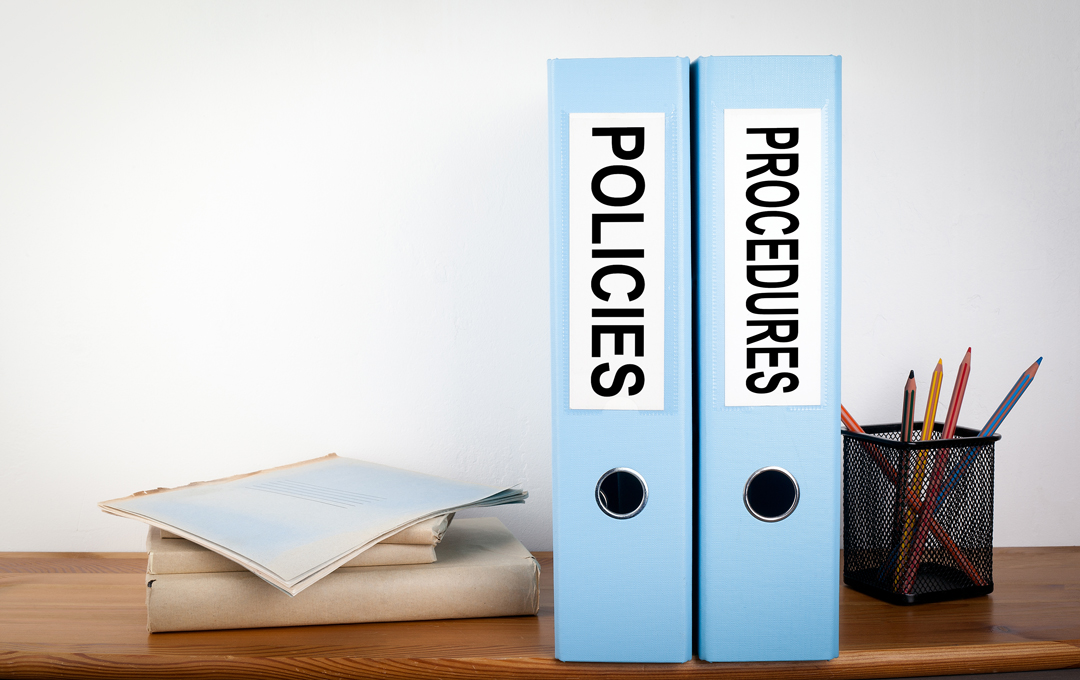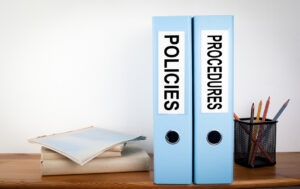What’s in your office compliance manual?
By Katherine Schrubbe
Now that 2021 has arrived and most have bid good riddance to 2020, what better way to ring in the new year than to take a fresh look at the practice and ensure the office compliance manual is in good order and complete.
Everyone has heard the commercial, “what’s in your wallet?” Despite the continued coronavirus pandemic, think about kicking-off 2021 in a positive direction, and ask “what’s in your office compliance manual?” The Occupational Safety and Health Administration (OSHA) has set safety standards for all types of workplaces and although there are currently no specific OSHA standards for dentistry, exposure to numerous biological, chemical, environmental, physical, and psychological workplace hazards that may apply to dentistry are addressed in specific OSHA standards for general industry.1 Many of the applicable standards require written plans that must be carried out in the practice, and these written plans form and become essential as part of the practice’s office compliance manual, sometimes known as the office OSHA manual.
Most dental service organizations (DSOs) and large group practices (LGPs) have internal infrastructure and key individuals responsible for managing compliance to OSHA standards. Even in these settings, ensuring there are readily available standardized and calibrated office compliance manuals is an ongoing job, and in private practices, this can be even more challenging. Although not a complete list, depending on the dental workplace setting, OSHA lists key standards that apply to many healthcare employers, and they are as follows:
- Bloodborne Pathogens Standard
- Hazard Communication Standard
- Ionizing Radiation Standard
- Exit Routes Standard
- Electrical Standard
- Emergency Action Plan Standard
- Fire Safety Standard
- Medical and First Aid Standard
- Personal Protective Equipment Standard.2
Not all these standards require written plans or may apply to all dental practices; some require specific actions to be taken or modifications to be made in the dental setting, and always include training of dental healthcare team members. The OSHA standards listed have been developed to address the common hazards in the healthcare workplace, but there could be additional potential safety and health hazards that may apply to dental healthcare facilities, such as those related to ergonomics, workplace violence, compressed gasses, lasers, and latex.3
A starting point
As discussed, required OSHA plans, as well as other guidance materials such as specific state guidelines form and comprise the contents of the office compliance manual. So, where to begin? A key written plan that must be included in the office compliance manual as directed by the OSHA Bloodborne Pathogens Standard is the Exposure Control plan, also known as the ECP. An ECP is the focal point of any bloodborne pathogens exposure prevention program and details in writing the plan for reducing exposures to blood/other potentially infectious materials, it also explains what steps to take if an exposure occurs.4
According to OSHA an ECP must meet certain criteria:
- be written specifically for each facility,
- be reviewed and updated at least annually (to reflect changes such as new worker positions or technology used to reduce exposures to blood or body fluids), and
- be readily available to all workers.5,6
Also, the employer must regularly educate dental team members on the uses of the ECP and where it is kept, so it is available when needed.
The Hazard Communication Standard also requires a written plan and is designed to ensure that employers and employees know about hazardous chemicals in the workplace and how to protect themselves.2 Dental settings definitely have chemicals in the workplace, such as disinfectants, ultrasonic solutions and dental materials used for patient care. The written program requires employers to maintain a list of the hazardous chemicals known to be present in the workplace. Using the product identifier (e.g., product name, common name, or chemical name) to prepare the list makes it easier to track the status of Safety Data Sheets (SDSs) and labels of a particular hazardous chemical.2,7
As far as the OSHA standard for ionizing radiation goes, it requires affected employers to conduct a survey of the types of radiation used in the facility, including dental X-rays, to designate restricted areas to limit employee exposure, and to require employees working in designated areas to wear personal radiation monitors.2 State plans and guidance documents should be included in the compliance manual to ensure team members are educated and trained on radiation safety, but OSHA does not require a specific additional plan. Under OSHA’s Ionizing Radiation standard (29 CFR 1910.1096), all employers must:
- ensure that occupational dose limits are not exceeded,
- survey radiation hazards to comply with the standard,
- supply appropriate personal monitoring,
- post caution signs, labels, and signals, and
- provide instruction to personnel and post-operating procedures.2,8
The next written plan to include in the office compliance manual is the Emergency Action Plan (EAP). OSHA recommends that all employers have an EAP that describes actions employees should take to ensure their safety in a fire or other emergency, such as severe weather, gas leaks, facility threats and violence; the plan is mandatory when required by an OSHA standard.2 It encompasses compliance to standards for exit routes in the practice as well as medical emergencies and other associated standards that may be specific for a workplace. According to OSHA, workplaces with more than 10 employees must have a written emergency action plan; smaller practices may communicate their plans orally.2,9
Dental practices sometimes inquire about the need for a separate fire protection plan. The fact is that only certain standards would prompt the need for this plan and in most cases, fire safety would be addressed in the EAP. OSHA standards that require fire prevention plans include the following: ethylene oxide (1910.1047), methylenedianiline (1910.1050) and 1,3 butadiene (1910.1051).2,10 These materials are not typically used in dental settings at this time.
With the onset of the current coronavirus pandemic, the Centers for Disease Control and Prevention (CDC) and OSHA continue to update their recommendations and guidance for dental health care providers related to personal protective equipment (PPE) and the delivery of patient care. Both agencies state during aerosol generating procedures (AGPs) dental healthcare providers should use an N95 respirator or a respirator that offers an equivalent or higher level of protection such as other disposable filtering facepiece respirators, powered air-purifying respirators (PAPRs), or elastomeric respirators; also, respirators should be used in the context of a comprehensive respiratory protection program, which includes medical evaluations, fit testing and training in accordance with the OSHA Respiratory Protection Standard (29 CFR 1910.134).11,12 Whenever OSHA standards or employers require respirator use, there must be a complete respiratory protection program and employers must have written operating procedures to ensure that employees use the respirators safely and properly.13
The last plan to include in the office compliance manual is a written infection control plan. According to CDC, written infection prevention policies and procedures based on evidence-based guidelines, regulations, or standards should be available and tailored to the dental setting and reassessed on a regular basis (e.g., annually) or according to state or federal requirements. Development should take into consideration the types of services provided by DHCP and the patient population served, extending beyond the OSHA bloodborne pathogens standard to address patient safety.14
There is no better time than a new year to evaluate and assess the practice’s office compliance manual for accuracy and to ensure the required written plans are complete and current. The written plans described here are key elements, but not necessarily a comprehensive list as different practice settings may require additional plans. It may seem an overwhelming task to find plan templates and complete them, however, there is no need to reinvent the wheel, as templates for many of these plans can be found on the osha.gov website for the associated specific standard. Start 2021 out right and make the office compliance manual the foundation of your practice. This will ensure that dental team members have a clear understanding of the safety and infection control programs that exist, and that patients receive the high-quality safe care they deserve. Ask again, “what’s in your compliance manual?”
References
1. US Department of Labor. Occupational Safety and Health Administration. Dentistry. Available at www.osha.gov/dentistry. Accessed January 11, 2021.
2. US Department of Labor. Occupational Safety and Health Administration. Compliance Assistance Quick Start – Health Care Industry. Available at www.osha.gov/complianceassistance/quickstarts/health-care#step1. Accessed January 11, 2021.
3. US Department of Labor. Occupational Safety and Health Administration. Compliance Assistance Quick Start – Health Care Industry. Available at www.osha.gov/complianceassistance/quickstarts/health-care#step2. Accessed January 11, 2021.
4. Centers for Disease Control and Prevention. NIOSH. Protect your employees with an exposure control plan. Available at www.cdc.gov/niosh/docs/2007-158/pdfs/2007-158.pdf?id=10.26616/NIOSHPUB2007158. Accessed January 11, 2021.
5. US Department of Labor. Occupational Safety and Health Administration. Bloodborne Pathogens (29 CFR Part 1910.1030). Available at www.osha.gov/laws-regs/regulations/standardnumber/1910/1910.1030. Accessed January 11, 2021.
6. Centers for Disease Control and Prevention. NIOSH. Correctional healthcare workers. Available at www.cdc.gov/niosh/topics/correctionalhcw/plan.html. Accessed January 11, 2021.
7. US Department of Labor. Occupational Safety and Health Administration. Steps to an effective hazard communication program for employers that use hazardous chemicals fact sheet. Available at www.osha.gov/Publications/OSHA3696.pdf. Accessed January 12, 2021.
8. US Department of Labor. Occupational Safety and Health Administration. Ionizing radiation. Available at www.osha.gov/ionizing-radiation/standards. Accessed January 12, 2021.
9. US Department of Labor. Occupational Safety and Health Administration. Planning and responding to workplace emergencies fact sheet. Available at www.osha.gov/OshDoc/data_General_Facts/factsheet-workplaceevergencies.pdf. Accessed January 12, 2021.
10. US Department of Labor. Occupational Safety and Health Administration. Fire safety fact sheet. Available at www.osha.gov/Publications/OSHA3527.pdf. Accessed January 12, 2021.
11. Centers for Disease Control and Prevention. Guidance for dental settings. Updates December 4, 2020. Available at www.cdc.gov/coronavirus/2019-ncov/hcp/dental-settings.html. Accessed January 13, 2021.
12. US Department of Labor. Occupational Safety and Health Administration. Dentistry workers and employers. Available at www.osha.gov/coronavirus/control-prevention/dentistry. Accessed January 13, 2021.
13. US Department of Labor. Occupational Safety and Health Administration. Respiratory protection. Available at www.osha.gov/Publications/osha3079.pdf. Accessed January 13, 2021.
14. Centers for Disease Control and Prevention. Summary of Infection Prevention Practices in Dental Settings: Basic Expectations for Safe Care. Atlanta, GA: Centers for Disease Control and Prevention, US Dept of Health and Human Services; October 2016.
Bio:
Katherine Schrubbe, RDH, BS, M.Ed, PhD is an independent compliance consultant with expertise in OSHA, dental infection control, quality assurance and risk management. She is an invited speaker for continuing education and training programs for local and national dental organizations, schools of dentistry and private dental groups. She has held positions in corporate as well as academic dentistry and continues to contribute to the scientific literature. Dr. Schrubbe can be reached at [email protected].






